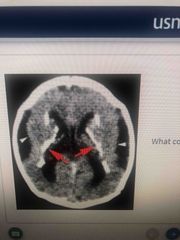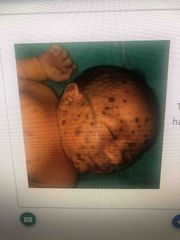![]()
![]()
![]()
Use LEFT and RIGHT arrow keys to navigate between flashcards;
Use UP and DOWN arrow keys to flip the card;
H to show hint;
A reads text to speech;
68 Cards in this Set
- Front
- Back
- 3rd side (hint)
|
Normal flora bacteria if the vagina |
Lactobacillus E. Coli Group B streptococcus |
|
|
|
Normal flora bacteria of the skin |
Staphylococcus epidermidis |
|
|
|
Normal flora bacteria of the nose |
Staphylococcus epidermidis Staphylococcus aureus |
|
|
|
Normal flora bacteria of the oropharynx |
Viridian strep |
|
|
|
Normal flora bacteria of the dental cavity |
Streptococcus mutan |
|
|
|
Normal flora bacteria of the dental cavity |
Streptococcus mutan |
|
|
|
Normal flora bacteria of the colon |
B. fragilis E. Coli |
|
|
|
B. Cereus, C. Botulinum, C. Perfringens and E.coli cause Ig food poisoning |
1- B. Cereus - reheat rice 2- C. Botulinum- Improperly canned foods (toxins), raw honey (toxins) 3- C. Perfringens- reheat meat 4- E. Coli - undercooked meat |
|
|
|
L. Monocytogenes, salmonella, S. Aureus and V parahamolyticus/ V vulnificus causing food poising |
1- L. Monocytogenes- Deli meat, soft cheese 2- Salmonella- Poultry, meat and eggs 3- S. Aureus - meat, mayonnaise, custard 4- V parahaemolyticus and V vulnificus - Raw/undercooked seafood |
|
|
|
What 2 microorganisms are associated with a quick onset and a quick resolution of food poisoning |
Bacillus cereus Staphylococcus aureus |
|
|
|
Bugs causing bloody diarrhea |
1- Campylobacter 2- E. Histolytica 3- Enterohemorrhagic E.coli 4- Enteroinvasive E. Coli 5- Salmonella (not typhi) 6- Shigella 7- Yersinia enterocolitica |
|
|
|
Bugs causing Watery diarrhea |
1- C. Difficle 2- C. Perfringens 3- Enterotoxigenic E. Coli 4- Protozoan- Giardia, Cryptosporidia 5- Vibrio cholera 6- Virus- Rotavirus, noravirus and enteric virus |
|
|
|
What is the most common cause of diarrhea in developed countries |
Norovirus |
|
|
|
Cause of pneumonia in neonate |
1- Group B strep 2- E. Coli |
|
|
|
Cause of pneumonia in children |
1- RSV 2- Mycoplasma 3- C trachomatis 4- C pneumonia 5- S. Pneumonia |
Runts May Cough Chunky Sputum |
|
|
Cause of pneumonia in adults (18- 40) |
1- Mycoplasma 2- C. Pneumonia 3- S. Pneumonia 4- Virus (eg influenza) |
|
|
|
Cause of pneumonia in adults (40-60) |
1- S. Pneumonia 2- H. Influenza 3- Anaerobes 4- Viruses 5- Mycoplasma |
|
|
|
Cause of pneumonia in elderly |
1- S. Pneumonia 2- Influenza 3- Anaerobes 4- H. Influenza 5- Gram negative rods |
|
|
|
Cause of pneumonia in alcoholic |
1- Klebsiella 2- Anaerobes |
|
|
|
Cause of pneumonia in IV drug user |
1- S. Pneumonia 2- S. Aureus |
|
|
|
Cause of atypical pneumonia |
Anaerobes |
|
|
|
Cause of atypical pneumonia |
1- Mycoplasma 2- Camydophila 3- Legionella 4- Virus (RSV, CMV, influenza, adenovirus) |
|
|
|
Cause of atypical pneumonia |
1- Mycoplasma 2- Camydophila 3- Legionella 4- Virus (RSV, CMV, influenza, adenovirus) |
|
|
|
Cause of pneumonia in cystic fibrosis |
1- Pseudomonas 2- S. Aureus 3- S. Pneumonia 4- Burkholderia |
|
|
|
Cause of pneumonia in immunocompromised patient |
1- S. Aureus 2- Enteric gram negative rods 3- Fungi 4- Virus 5- P. Jirovecii |
|
|
|
Cause of nosocomial pneumonia |
1- S. Aureus 2- Psedomonas |
|
|
|
Cause of post viral pneumonia |
1- S. Pneumonia 2- S. Aureus 3- H. Influenza |
|
|
|
Which species of chlamydia cause pneumonia in children <3 |
Chlamydia trachomatis |
|
|
|
Cause of meningitis in neonate |
1- Group B streptococcus 2- E. Coli 3- Listeria |
|
|
|
Cause of meningitis in neonate |
1- Group B streptococcus 2- E. Coli 3- Listeria |
|
|
|
Cause of meningitis in children |
1- S. Pneumonia 2- N. Meningitidis 3- H. Influenza 4- Group B streptococcus 5- Enterovirus |
|
|
|
Cause of meningitis in adults |
1- N. Meningitis 2- Strep pneumonia 3- Enterovirus 4- HSV |
|
|
|
Cause of meningitis in elderly |
1- Streptococcus pneumonia 2- N. Meningitis 3- H. Influenza 4- Group B streptococcus 5- Listeria |
|
|
|
What fungal organism cause meningitis and are associated with HIV |
Cryptococcal species |
|
|
|
5 viral cause of meningitis |
1- Coxsackievirua 2- HIV 3- HSV- 2 4- West Nile virus 5- VZV |
|
|
|
What are the initial steps in treatment of a patient with suspected meningitis |
Ceftriaxone and vancomycin empirically Ampicillin for listeria |
|
|
|
CSF in bacteria |
1- Pressure - increase 2- Cell type - PMN 3- Protein- increase 4- Glucose - decrease |
|
|
|
CSF I’m fungal/TB |
1- Pressure- increase 2- Cell type- lymphocytes 3- Protein- increase 4- Glucose - decrease |
|
|
|
CSF in virus |
1- Pressure- normal or increase 2- Cell type- Lymphocytes 3- Protein- normal or increase 4- Glucose - normal |
|
|
|
Infectious cause of brain abscess |
1- Staphylococcus aureus 2- Streptococcus Viridans 3- Oral anaerobes of dental infection or extraction preceded abscess 4- Multiple abscess- bacteria 5- Single abscess- Contiguous spread (otitis media, mastoiditis, sinusitis or dental infection) 6- Toxoplasmosis in AIDS |
|
|
|
Location of brain abscess |
1- Temporal lobe and cerebellum- 1- otitis media 2- mastoiditis 2- Frontal lobe- 1- Sinusitis 2- Dental infection |
|
|
|
Cause of osteomyelitis |
1- Most common- S. Aureus 2- Sexual active- N. Gonorrhea 3- Suckle cell disease - salmonella and staph aureus 4- Prosthetic joint replacement - S. Aureus and S. Epidermidis 5- Vertebral involvement - S. Aureus and Mycobacterium tuberculosis (Potts disease) 6- Cat and Dog bite- Pasteurella multicida 7- IV drug users - S. Aureus , Pseudomonas and Candida |
|
|
|
What diagnostic test is used to identify the organism in osteomyelitis |
Culture of biopsy or aspirate |
|
|
|
Common causes of UTI |
1- E. Coli 2- Staphylococcus saprophyticus 3- Klebsiella pneumonia |
|
|
|
Nosocomial causes of UTI |
1- Serratia marcescens 2- Enterococcus- often drug resistant 3- pseudomonas aeruginosa |
|
|
|
Nosocomial causes of UTI |
1- Serratia marcescens 2- Enterococcus- often drug resistant 3- pseudomonas aeruginosa |
|
|
|
Bacteria cause strive Stone leading to UTI |
Proteus |
|
|
|
Diagnostic markers of UTI |
1- Leukocytes esterase - evidence of WBC activity 2- Positive nitrite - gram negative bacteria reduce nitrate 3- Urease positive- urease producing bugs ( staph. Saprophyticus, Klebsiella and proteus) |
|
|
|
Why are UTI 10x more common in female |
Short urethra |
|
|
|
What is the pathophysiology behind pyelonephritis |
Ascending infection from the bladder to the kidney |
|
|
|
What is the most common route of transmission for microbes that cause urinary tract infection |
Ascending infection from urethra to bladder |
|
|
|
Predisposing factor for UTI |
1- Female sex 2- Obstruction 3- Catheterization 4- Congenital genitourinary malformation 5- Pregnancy 6- Diabetes |
|
|
|
What finding on urinalysis can help distinguish a urinary tract infection from pyelonephritis |
WBC cast in pyelonephritis |
|
|
|
Lab finding for bacteria vaginosis |
1- Clue cells 2- pH> 4.5 3- Positive KOH test |
|
|
|
Diagnosis of Trichomonas vaginalis |
1- Motile pear shaped trichomonads 2- pH >4.5 |
|
|
|
Diagnosis of Trichomonas vaginalis |
1- Motile pear shaped trichomonads 2- pH >4.5 |
|
|
|
Diagnosis of Candida vulvaginalis |
1- pseudohypha 2- pH (4-4.5) |
|
|

Diagnosis |
Periventricular calcification CMV |
|
|

Diagnosis |
Toxoplasmosis gondii |
|
|
|
How does a rubella infection typically present in a pregnant patient |
1- Rash 2- Poly arthritis 3- Poly Arthralgia 4- Lymphadenopathy |
|
|
|
Causes of rash in children |
1- Coxsackievirus 2- HHV 6/7(roseola)- truck then extremities 3- Measles - hand to toes, 4 Cs 4- Parvovirus B19- Slapped cheek 5- Rubella- head to toes painless postauricular lymphadenopathy 6- Group A strep- Scarlet fever 7- VZV- trunk to extremity |
|
|
|
2 most common cause of nosocomial infection |
Staphylococcus aureus E. coli |
|
|
|
Infection related to water aerosols |
Legionella |
|
|
|
Hemophilus ducreyi |
1- Chancroid 2- Painfull genital ulcers with exudate 3- Inguinal adenopathy |
|
|
|
Klebsiella granulomatous (Calymmatobacterium) |
1- Granuloma inguinale (Donovanosis) 2- Painless beefy red ulcer that bleed on contact 3- Cytoplasmic Donovan bodies (bipolar stain) seen on microscopy |
|
|
|
What are the two causes of painfull ulcers |
HSV 2 Chancroid |
|
|
|
Pelvic inflammatory disease |
1- Cause 1- Chlamydia trichamatis 2- Neisseri gonorrhea 2- Signs- 1- Supra pubic tenderness 2- Purulent cervical discharge 3- Cervical motion tenderness 4- Adnexal tenderness 3- Complication 1- Salpingitis 2- Endometritis 3- Tubo-ovarian abscess 4- Hudrosalpinx 4- Salpingitis causes 1- Ectopic pregnancy 2- Infertility 3- Chronic pelvic pain 4- Adhesion 5- Can cause Fitz Hugh Curtis syndrome (peri hepatitis)- infection and inflammation of liver capsule with violin string adhesion of peritoneum to liver |
|
|
|
Fitz hug Curtis syndrome |
Infection and inflammation of liver capsule with violin string adhesion of peritoneum to the liver |
|

